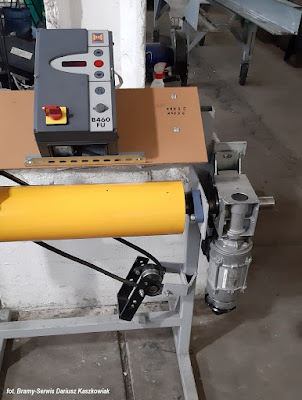photo: Bramy-Serwis Dariusz Kaszkowiak
Good practices and investments related to Cleaner Production
Example No. 44
Recycling of defective high-speed door controllers - improving service by building a dynamometer with a measuring system
Company:
Bramy-Serwis Dariusz Kaszkowiak
Industry branch: service
Activity name: servicing industrial doors
Resources in question:
- Thermal energy
- Electrical energy
- Fossil fuels
- Waste
- Emissions into the atmosphere
(PLN 18,000 – the cost of materials needed to build a dynamometer)
Description of the problem:
Typically, the failure of a high-speed door controller requires the service to carry out a lengthy process of identifying the type of controller and pricing it. The average troubleshooting time for a defective high-speed door controller in Poland ranges from 17 to 65 working days (4 to 13 weeks) and usually ends with the replacement of the controller with a new one. The consequences of door downtime during cold periods of the year are energy losses in companies (higher electricity and/or heat consumption).
The experience gained during 9 years helped Bramy-Serwis make quick repairs of controllers (so they do not become waste, but receive a “second life”). Some repairs can be done in a few hours (at the customer's site), but with some it is necessary to take the controller to the company (the repair then takes about 5 days).
The variety of design, size and speed of the doors is so wide that it is important to test the functionality of the controller as best as possible after repair. Further shortening of the time for implementation of the work in the service center was therefore conditioned by the best possible simulation of the behavior of the repaired controller in the conditions in which it will work at the customer’s site, so as to avoid the situation when it turns out at the customer's site that further service work is necessary (limiting the need for next trips and the loss of time and energy wasted by the open, damaged door).
However, wanting to test equipment even better and faster, the company has developed the concept of implementing the design of a proprietary dynamometer with a measuring system.
A dynamometer is a system that simulates the behavior of the door as close as possible to the conditions under which the repaired controller will operate at the customer's site, through the appropriate selection of its selected operating parameters. Testing the controller on such a system allows for much better verification of how it will operate when installed at the target site. Benefits of the developed solution are:
- The possibility of easy, quick installation of a high-speed door drive (of any type found in the industry series),
- The ability to smoothly adjust the drive load during drive operation,
- The ability to measure the set force with a dynamometric measuring device.
Obtained benefits and effects of the implementation:
- Benefits of implementation of a dynamometer:
- reduced energy losses at customers’ sites (faster repair of a broken door), and thus also indirectly reduced impacts accompanying its production (fuel consumption, waste, emissions, reduction of carbon footprint)
- reduced time and transportation, by better testing of controllers on site at the service center (avoiding the need for several visits to the customer during a single repair, thus reducing fuel consumption and emissions from transportation)
- savings (due to reduced working time of the personnel performing the tests, not including lower fuel costs): approx. PLN 20,500/year (payback period: approx. 10.5 months)
- In general, thanks to the repair of controllers that do not become waste:
- in 2020, the recycled controllers contained: about 34 kg of metals, about 380 kg of plastics and about 80 kg of other printed circuit board (PCB) components, not listed above
- Report on the Cleaner Production Project No. 2ind.751, developed within the framework of the Cleaner Production Academy at Bramy-Serwis Dariusz Kaszkowiak: "Defective high-speed door controllers recycled in a closed circuit"
- Materials (including photos) sent by the company Bramy-Serwis Dariusz Kaszkowiak
Polish version:









0 komentarze :
Prześlij komentarz